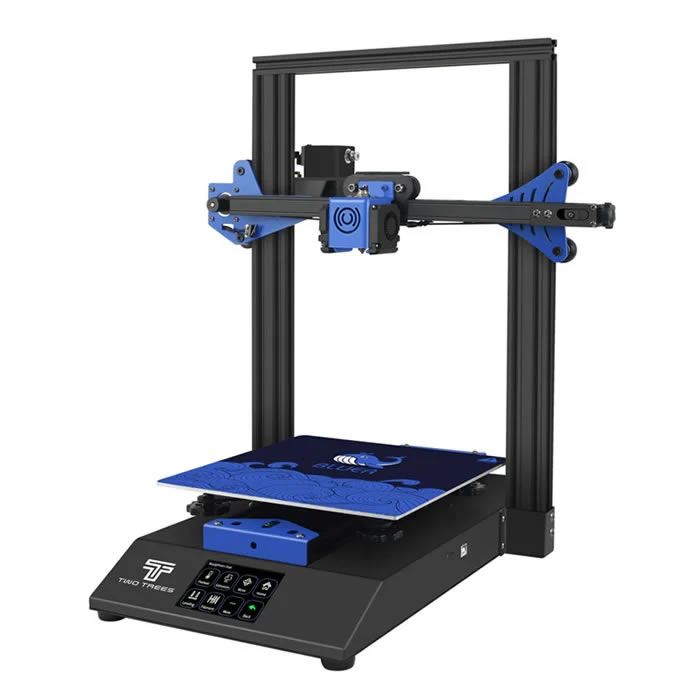Compare Bluer vs K1 Max
Comparison between the best 3D printers
Choose the best 3D printer at the best price. The cheapest 3D printers are here.
Buy a 3D printer here with 3D Fila.
 |
 |
|
| Model | Bluer |
K1 Max[BUY K1 Max] |
| Printing Material | Filament | Filament |
| Buy Filament for TwoTrees Bluer | Buy Filament forCreality 3D K1 Max | |
| Estimated price | $169,00 | $1300,00 |
| Manufacturer | TwoTrees | Creality 3D |
| Release Year | 2019 | 2023 |
| Print Volume [mm] | 230x230x280 | 300x300x300 |
| Printer Size [mm] | 400x410x520 | 435x462x526 |
| Weight [kg] | 8 | 18 |
| Power Loss Recovery | YES | YES |
| Enclosed printer | NO | YES |
| Bed Leveling | Manual | Automatic |
| Filament End Sensor | YES | YES |
| Bed type | Heated | Heated |
| Power supply system | Bowden | Direct Drive |
| Standard nozzle | 0,4 | 0,4 |
| Maximum Nozzle Temperature [°C] | 260 | 300 |
| Maximum Bed Temperature [°C] | 100 | 100 |
| Maximum printing speed [mm/s] | 200 | 600 |
| Filament holder | YES | YES |
| Camera for supervision | NO | NO |
| Recommended filaments | PLA, PETG | ABS, PLA, PETG, TPU, PA, ASA, PC, PLA-CF, PA-CF, PET-CF |
| Recommended slicers | Cura, Simplify, Slic3r | Creality Print, Cura, Simplify, Slic3r, IdeaMaker e outros |
| Maximum Resolution [mm] | 0,1 | 0,1 |
| Processor | MKS Robin Nano V1.2 + TMC2208 | |
| Display | Touchscreen TFT 3,5'' | Display touchscreen 4,3'' |
| Power Supply | 240W | |
| Connectivity | SD / USB | USB / Wi-Fi / Ethernet |
| Operating systems | Windows, Mac, Linux | Windows, Mac, Linux |
| Date of registration in the system | 2021-09-20 | 2023-12-01 |
| Release date | 2019 | 2023 |
| Extra features | The Bluer offers interesting features such as automatic bed leveling, a 3.5-inch color touchscreen for easy operation, and a filament sensor to prevent print failures. It has a robust metal extruder and a generous 230 x 230 x 280 mm print volume, suitable for a variety of projects. The community mentions improvements made by Two Trees based on feedback, increasing its reliability. | The Creality K1 Max stands out as a fast Core XY 3D printer with a large build volume of 300 x 300 x 300 mm. It is fully enclosed and equipped with AI sensors to prevent print failures. This model has a smooth and flexible PEI build platform, and uses an automatic leveling system with LIDAR, as well as a filament run-out sensor. LAN, Creality Cloud and USB Flash Disk connectivity are available, as well as a 4.3-inch touchscreen interface. The K1 Max is robust, weighing in at 18 kg, and includes an AI camera and limited version of the Klipper firmware. Its motion system is solid and the printer is efficient with high-temperature filaments, but it is not silent. Assembly is 99% complete, requiring only minor adjustments before use. |
| Support for multiple colors and materials (AMS and CFS) | NO | NO |
Notes * |
||
| Cost-benefit | 7 / 10 | 7 / 10 |
| Hardware | 2 / 10 | 4.2 / 10 |
| Tela | . | . |
| Print volume | 3 / 10 | 4 / 10 |
| Performance | 2 / 10 | 5 / 10 |
| [BUY K1 Max] |
Conclusion |
| In comparing the TwoTrees Bluer and the Creality 3D K1 Max, several key factors emerge that highlight the strengths and weaknesses of each model. The Bluer, while significantly more affordable, offers a decent print volume and essential features such as a heated bed and a filament sensor, making it a suitable choice for hobbyists and those new to 3D printing. Its simplicity and manual bed leveling may appeal to users looking for a straightforward entry-level experience. On the other hand, the K1 Max, with its higher price point, showcases advanced features that justify the investment, particularly for serious enthusiasts or professionals. With a larger print volume, automatic bed leveling, and higher printing speed, it is designed for scalability and efficiency. Its enclosed design and support for a wide range of high-temperature filaments make it more versatile for complex projects. Additionally, connectivity options such as Wi-Fi and LAN, along with a user-friendly touchscreen interface, enhance the overall user experience. Overall, the choice between these printers hinges on budget and intended usage. The Bluer excels in cost-effectiveness and is perfect for beginners, while the K1 Max is a robust option for those willing to invest more for advanced features and performance. Depending on your specific 3D printing needs, either model could be the right fit, but the K1 Max clearly offers superior technological advancements and capabilities. |

